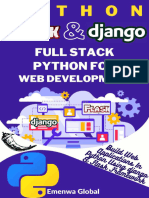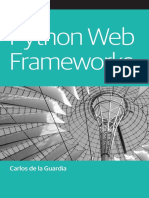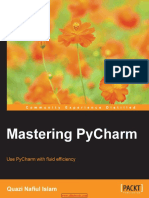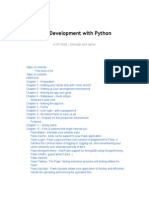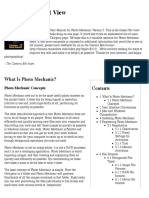Django Tutorial
Uploaded by
tcdnetsocDjango Tutorial
Uploaded by
tcdnetsocDjango
Web Development for
Perfectionists with Deadlines
Thursday 24 February 2011
Framework
» Models
» Define how a piece of data looks and works.
» Forget SQL, Django handles the database.
» Views
» A URL is mapped to a view.
» View pulls some objects based on a query.
» Creates a rendering context.
» Templates
» HTML code with some extra tags that insert some
content from the context.
Thursday 24 February 2011
A Django Project
» Separated into ‘apps’.
» Examples: /news/, /photos/, /events/
» Each app has its own models, views,
templates.
» A global URL mapper turns a URL into
a view located inside an app.
Thursday 24 February 2011
Speed Through It
Thursday 24 February 2011
Model
class Photo(models.Model):
name = models.CharField(max_length=100)
file = models.ImageField()
owner = models.ForeignKey(User)
pub_date = models.DateTimeField()
description = models.TextField()
Thursday 24 February 2011
URL Map
url variable, will be passed as keyword argument to view function
(r‘photos/(?P<id>\d+)/$’, ‘photos.show_photo’),
regex describing url path
python package path to view function
Thursday 24 February 2011
View
def show_photo(request, id):
photo = Photo.objects.get(id=id)
context = { ‘photo’: photo }
return render_to_response(‘photo.html’, context)
Thursday 24 February 2011
Template
{% extends ‘base.html’ %}
{% block content %}
<h2>{{ photo.title }}</h2>
<em>Uploaded by: {{ photo.owner.username }}<em></br>
<img src=”{{ photo.url }}” />
<p>
{{ photo.description }}
</p>
{% endblock %}
Thursday 24 February 2011
Installing Django
» Install Python! (duh)
» Install setuptools
» $ easy_install django
» > C:\Python2x\scripts\easy_install.exe django
Thursday 24 February 2011
Start a Project
» django-admin.py startproject mysite
Thursday 24 February 2011
Start an App
» cd mysite
» ./manage.py startapp photos
Thursday 24 February 2011
File Layout
__init__.py
manage.py
photos
photos/__init__.py
photos/models.py
photos/tests.py
photos/views.py
settings.py
urls.py
templates/base.html
templates/photo.html
Thursday 24 February 2011
manage.py
» ./manage.py startapp [appname]
» ./manage.py runserver
» ./manage.py syncdb
Thursday 24 February 2011
settings.py
» Edit database config.
» Set up locale, timezones, translation.
» Set template directories.
» Load middleware.
» Load apps.
Thursday 24 February 2011
Built-in Apps
» Django comes with loads of built in
apps for various purposes.
» User authentication.
» Sessions.
» Admin site.
» Etc etc.
Thursday 24 February 2011
Designing URLs
page.php
script.cgi?pageid=144
StoryPage.aspx
Thursday 24 February 2011
Designing URLs
0,2097,1-1-30-72-407-4752,00.html
Thursday 24 February 2011
Designing URLs
photos/
photos/14/
photos/hamilton-at-night/
Thursday 24 February 2011
urls.py
from django.conf.urls.defaults import *
from django.contrib import admin
admin.autodiscover()
urlpatterns = patterns('',
(r'^admin/doc/', include('django.contrib.admindocs.urls')),
(r'^admin/', include(admin.site.urls)),
(r ^photos/(?P<id>\d+)/$ , photos.show_photo ),
(r ^$ , photos.index ),
)
Thursday 24 February 2011
About Models
» No SQL needed, Django handles it for whatever kind
of database you choose in settings.py.
» SQLite for dev, deploy on MySQL, move to
Postgres later - no problem.
» Never risk SQL Injection. i.e. concatenating an SQL
query with some content a user submitted in a
form in order to construct a full query.
» Django lazily evaluates queries, won’t run a query
until you need to enumerate and print the result.
» Uses QuerySet objects for sorting, filtering,
querying.
Thursday 24 February 2011
About QuerySets
>>> Photo.objects.all()
>>> Photo.objects.filter(uploaded = today())
>>> Photo.objects.filter(name__startswith = ”Pants”)
>>> Photo.objects.filter(owner =
User.objects.get(username=”theorie”))
Can also union and intersect querysets, drop into
SQL whenever you want.
Thursday 24 February 2011
Updating objects
>>> p = Photos.objects.get(id=some_id)
>>> p.name = “A new name”
>>> p.save() # photo has been saved to the db
Thursday 24 February 2011
Admin Site
» Rapid development of new features.
» Knock out a model in 5 minutes.
» Get a writer on the admin site pushing
content.
» Finish view logic and templates.
» Feature deployed within the hour.
Thursday 24 February 2011
Thursday 24 February 2011
Thursday 24 February 2011
Thursday 24 February 2011
Batteries Included
» Generic Views
» Syndication
» Auth/Auth
» Comments
» i18n/l10n
» Caching framework
Thursday 24 February 2011
Generic Views
from mysite.models import Photo
patterns = urlpatterns( ,
(r ^photos/$ ,
django.views.generic.list_detail.object_list ,
{
queryset : Photo.objects.all(),
paginate_by : 30
}
),
Thursday 24 February 2011
Syndication
from django.contrib.syndication.feeds import Feed
from mysite.models import Photo
class PhotoFeed(Feed):
title = My Photo Feed
link = /photos/
description = Photos from my site
def items(self):
return Photo.objects.all()[:20]
Thursday 24 February 2011
Syndication
» (r’^feeds/photos/$’, PhotoFeed()),
Thursday 24 February 2011
Auth/Auth
» Abstracted, use any method you want.
» Built-in Users, Groups, Permissions in
django.contrib.auth
» Authenticate using the local database.
» user = authenticate(username, password)
» user.login() if user != None
» Attach any other auth system you can think of.
» Many available on the internet: LDAP, ActiveDirectory,
etc.
» Write your own, make a class that implements
authenticate(user, pass) and get_user(id), add it to
AUTHENTICATION_BACKENDS in settings.py
Thursday 24 February 2011
Auth/Auth
» Netsoc uses our own auth backend, based
on the LDAP method.
» Though unless you want to query LDAP
every time you need some user’s info, it’s
best to cache the user data in Django’s User
database locally as well.
» We also run through the LDAP groups that
the user belongs to and tag the local django
copy with things like is_staff and
is_superuser if the account is an admin or
member of webteam.
Thursday 24 February 2011
Comments
{% load comments %}
{% get_free_comment_list
for photos.photos photo.id
as comments %}
{% for comment in comments %}
<h3>{{ comment.person_name }} said:</h3>
<p>{{ comment.comment }}</p>
{% endfor %}
Thursday 24 February 2011
Comments
{% free_comment_form for photos.photos photo.id %}
Thursday 24 February 2011
i18n/l10n
» Django’s core is translated into 63 languages.
» Easy to add localization to your projects.
» from django.utils.translation import ugettext as _
» _(“This text will be translated”)
» {% trans “This text will be translated” %}
» django-admin.py makemessages -l fr
» django-admin.py compilemessages
» request.session[‘django_language’] = ‘fr’
Thursday 24 February 2011
Caching
» Various caching middleware is included.
» Filesystem
» Local memory
» Memcached
» Write your own caching backend.
» Add it to CACHES in settings.py
» Cache a whole view.
» Just cache part of a template, save caches based
on tags like username, language code, to keep
them relevant.
Thursday 24 February 2011
Learn More
» djangoproject.com
» Thanks for coming.
» Slides are on netsoc.tcd.ie
Thursday 24 February 2011
You might also like
- Andrey Bulezyuk - Django 3 - For Beginners (2021)100% (1)Andrey Bulezyuk - Django 3 - For Beginners (2021)347 pages
- RailTel PSCDL-RFP-Vol-2 Merged ModifiedNo ratings yetRailTel PSCDL-RFP-Vol-2 Merged Modified324 pages
- Building Web Apps with Python and Flask: Learn to Develop and Deploy Responsive RESTful Web Applications Using Flask Framework (English Edition)From EverandBuilding Web Apps with Python and Flask: Learn to Develop and Deploy Responsive RESTful Web Applications Using Flask Framework (English Edition)4/5 (1)
- Building Websites with Django: Build and Deploy Professional Websites with Python Programming and the Django Framework (English Edition)From EverandBuilding Websites with Django: Build and Deploy Professional Websites with Python Programming and the Django Framework (English Edition)No ratings yet
- Django - The Easy Way A Step-By-Step Guide On Building Django Websites, 2nd Edition (PDFDrive)100% (2)Django - The Easy Way A Step-By-Step Guide On Building Django Websites, 2nd Edition (PDFDrive)165 pages
- Django Web Development With Python 1787121380 SAMPLE0% (1)Django Web Development With Python 1787121380 SAMPLE19 pages
- Django Cookbook Web Development With Django - Step by Step GuideNo ratings yetDjango Cookbook Web Development With Django - Step by Step Guide153 pages
- Python Master The Art of Design Patterns by Dusty Phillips, Chetan Giridhar, Sakis Kasampalis 1787125181 2016 SAMPLE33% (3)Python Master The Art of Design Patterns by Dusty Phillips, Chetan Giridhar, Sakis Kasampalis 1787125181 2016 SAMPLE21 pages
- Web Development With Django Cookbook - Second Edition - Sample Chapter100% (1)Web Development With Django Cookbook - Second Edition - Sample Chapter40 pages
- Python Fundamentals Object Oriented Python: Web Development With Django Unit Testing With Python (Pytest) Design PatternsNo ratings yetPython Fundamentals Object Oriented Python: Web Development With Django Unit Testing With Python (Pytest) Design Patterns30 pages
- Tkinter GUI Application Development Blueprints - Sample Chapter100% (6)Tkinter GUI Application Development Blueprints - Sample Chapter45 pages
- Python 5 Manuscripts - Python For Beginners, Python Programming, Hacking With Python, Tor, Bitcoin100% (8)Python 5 Manuscripts - Python For Beginners, Python Programming, Hacking With Python, Tor, Bitcoin620 pages
- Django Design Patterns and Best Practices - Sample ChapterNo ratings yetDjango Design Patterns and Best Practices - Sample Chapter27 pages
- Python Flask For Web Development. Build Web Applications... 2022100% (1)Python Flask For Web Development. Build Web Applications... 2022114 pages
- Muhammad Yasoob Ullah Khalid - Practical Python Projects-Muhammad Yasoob Ullah Khalid (2021)100% (2)Muhammad Yasoob Ullah Khalid - Practical Python Projects-Muhammad Yasoob Ullah Khalid (2021)329 pages
- What You Need To Know About Python (Ebook) - Pierluigi Riti75% (4)What You Need To Know About Python (Ebook) - Pierluigi Riti66 pages
- Python Programming Illustrated For Beginners & Intermediates: “Learn By Doing” Approach-Step By Step Ultimate Guide To Mastering Python: The Future Is Here!: The Future Is Here!From EverandPython Programming Illustrated For Beginners & Intermediates: “Learn By Doing” Approach-Step By Step Ultimate Guide To Mastering Python: The Future Is Here!: The Future Is Here!4/5 (2)
- Testing Python: Applying Unit Testing, TDD, BDD and Acceptance TestingFrom EverandTesting Python: Applying Unit Testing, TDD, BDD and Acceptance Testing3.5/5 (2)
- Stardom Fcn-Rtu: Low Power Autonomous ControllerNo ratings yetStardom Fcn-Rtu: Low Power Autonomous Controller1 page
- Users Guide To Taking A Nutanix Certification ExamNo ratings yetUsers Guide To Taking A Nutanix Certification Exam12 pages
- IGCSE ICT Chapter 8 - Safety and SecurityNo ratings yetIGCSE ICT Chapter 8 - Safety and Security43 pages
- Project Title: Company Name Project LeadNo ratings yetProject Title: Company Name Project Lead3 pages
- Openshift Container Platform 4.14 Virtualization en Us 1 200100% (1)Openshift Container Platform 4.14 Virtualization en Us 1 200200 pages
- 2024 - Advanced Database Systems - 83858No ratings yet2024 - Advanced Database Systems - 838583 pages
- BLCC610I Solution 6000 Installation Manual FTR2.6No ratings yetBLCC610I Solution 6000 Installation Manual FTR2.6190 pages
- Basic Pentesting - 2 - CTF Walkthrough - Infosec ResourcesNo ratings yetBasic Pentesting - 2 - CTF Walkthrough - Infosec Resources9 pages
- Note Book Laptops: 1. HP 15 - Intel CeleronNo ratings yetNote Book Laptops: 1. HP 15 - Intel Celeron3 pages
- Download Complete (Ebook) Cybercrime and Digital Deviance by Graham, Roderick S., Smith, 'Shawn K. ISBN 9781032249193, 9781003283256, 9781040011171, 9781040011218, 1032249196, 100328325X, 1040011179, 1040011217 PDF for All Chapters100% (5)Download Complete (Ebook) Cybercrime and Digital Deviance by Graham, Roderick S., Smith, 'Shawn K. ISBN 9781032249193, 9781003283256, 9781040011171, 9781040011218, 1032249196, 100328325X, 1040011179, 1040011217 PDF for All Chapters77 pages
- Oracle 11g Business Intelligence Enterprise Edition (OBIEE)No ratings yetOracle 11g Business Intelligence Enterprise Edition (OBIEE)6 pages
- Csca Shopping Centre Database Data DictionaryNo ratings yetCsca Shopping Centre Database Data Dictionary3 pages
- Unveiling The Mystery of Internet Packet Forwarding: A Survey of Network Path ValidationNo ratings yetUnveiling The Mystery of Internet Packet Forwarding: A Survey of Network Path Validation34 pages
- (Untitled) : This Spreadsheet Was Created by Either POM, QM or POM-QM For Windows, V4No ratings yet(Untitled) : This Spreadsheet Was Created by Either POM, QM or POM-QM For Windows, V47 pages
- Building Web Apps with Python and Flask: Learn to Develop and Deploy Responsive RESTful Web Applications Using Flask Framework (English Edition)From EverandBuilding Web Apps with Python and Flask: Learn to Develop and Deploy Responsive RESTful Web Applications Using Flask Framework (English Edition)
- Building Websites with Django: Build and Deploy Professional Websites with Python Programming and the Django Framework (English Edition)From EverandBuilding Websites with Django: Build and Deploy Professional Websites with Python Programming and the Django Framework (English Edition)
- Django - The Easy Way A Step-By-Step Guide On Building Django Websites, 2nd Edition (PDFDrive)Django - The Easy Way A Step-By-Step Guide On Building Django Websites, 2nd Edition (PDFDrive)
- Django Web Development With Python 1787121380 SAMPLEDjango Web Development With Python 1787121380 SAMPLE
- Django Cookbook Web Development With Django - Step by Step GuideDjango Cookbook Web Development With Django - Step by Step Guide
- Python Master The Art of Design Patterns by Dusty Phillips, Chetan Giridhar, Sakis Kasampalis 1787125181 2016 SAMPLEPython Master The Art of Design Patterns by Dusty Phillips, Chetan Giridhar, Sakis Kasampalis 1787125181 2016 SAMPLE
- Web Development With Django Cookbook - Second Edition - Sample ChapterWeb Development With Django Cookbook - Second Edition - Sample Chapter
- Python Fundamentals Object Oriented Python: Web Development With Django Unit Testing With Python (Pytest) Design PatternsPython Fundamentals Object Oriented Python: Web Development With Django Unit Testing With Python (Pytest) Design Patterns
- Tkinter GUI Application Development Blueprints - Sample ChapterTkinter GUI Application Development Blueprints - Sample Chapter
- Python 5 Manuscripts - Python For Beginners, Python Programming, Hacking With Python, Tor, BitcoinPython 5 Manuscripts - Python For Beginners, Python Programming, Hacking With Python, Tor, Bitcoin
- Django Design Patterns and Best Practices - Sample ChapterDjango Design Patterns and Best Practices - Sample Chapter
- Python Flask For Web Development. Build Web Applications... 2022Python Flask For Web Development. Build Web Applications... 2022
- Muhammad Yasoob Ullah Khalid - Practical Python Projects-Muhammad Yasoob Ullah Khalid (2021)Muhammad Yasoob Ullah Khalid - Practical Python Projects-Muhammad Yasoob Ullah Khalid (2021)
- What You Need To Know About Python (Ebook) - Pierluigi RitiWhat You Need To Know About Python (Ebook) - Pierluigi Riti
- Python Programming Illustrated For Beginners & Intermediates: “Learn By Doing” Approach-Step By Step Ultimate Guide To Mastering Python: The Future Is Here!: The Future Is Here!From EverandPython Programming Illustrated For Beginners & Intermediates: “Learn By Doing” Approach-Step By Step Ultimate Guide To Mastering Python: The Future Is Here!: The Future Is Here!
- Testing Python: Applying Unit Testing, TDD, BDD and Acceptance TestingFrom EverandTesting Python: Applying Unit Testing, TDD, BDD and Acceptance Testing
- Users Guide To Taking A Nutanix Certification ExamUsers Guide To Taking A Nutanix Certification Exam
- Openshift Container Platform 4.14 Virtualization en Us 1 200Openshift Container Platform 4.14 Virtualization en Us 1 200
- Basic Pentesting - 2 - CTF Walkthrough - Infosec ResourcesBasic Pentesting - 2 - CTF Walkthrough - Infosec Resources
- Download Complete (Ebook) Cybercrime and Digital Deviance by Graham, Roderick S., Smith, 'Shawn K. ISBN 9781032249193, 9781003283256, 9781040011171, 9781040011218, 1032249196, 100328325X, 1040011179, 1040011217 PDF for All ChaptersDownload Complete (Ebook) Cybercrime and Digital Deviance by Graham, Roderick S., Smith, 'Shawn K. ISBN 9781032249193, 9781003283256, 9781040011171, 9781040011218, 1032249196, 100328325X, 1040011179, 1040011217 PDF for All Chapters
- Oracle 11g Business Intelligence Enterprise Edition (OBIEE)Oracle 11g Business Intelligence Enterprise Edition (OBIEE)
- Unveiling The Mystery of Internet Packet Forwarding: A Survey of Network Path ValidationUnveiling The Mystery of Internet Packet Forwarding: A Survey of Network Path Validation
- (Untitled) : This Spreadsheet Was Created by Either POM, QM or POM-QM For Windows, V4(Untitled) : This Spreadsheet Was Created by Either POM, QM or POM-QM For Windows, V4


